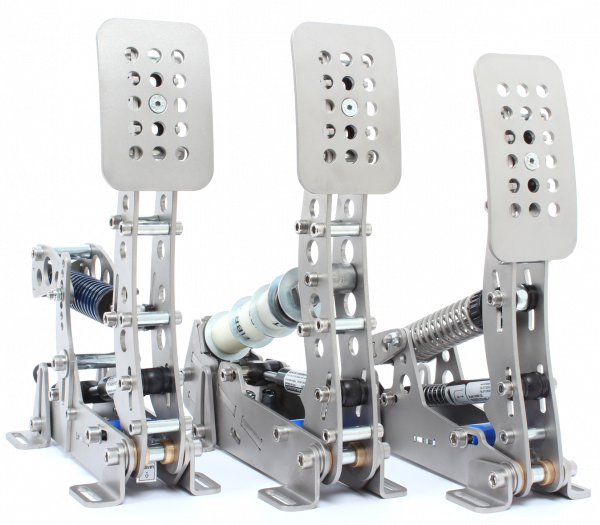Pedals
As in real cars, there are usually two pedal setups in sim racing: an accelerator pedal, brake pedal, and clutch pedal as in any car with a manual or sequential gearbox, or only accelerator and brake as in cars with dual-clutch transmissions.
Just like in real race cars, pedals are often mounted in an upright position in sim racing, although this is partially due to the design of the simulators not offering brackets to mount hanging pedals. To get the best driving experience, it is important to position the pedals correctly. In some cases, this also means that the pedals are installed at a slight upwards angle that may seem weird at first glance. In addition, you should make sure that the pedals are mounted on a proper, stable surface that sustains the relatively high forces that act while breaking. Those forces can be higher depending on the model and construction type. Too much movement on the mounting brackets can massively affect the driving experience and as a worst-case even damage the rig! Therefore, we pay special attention to the rigidity of all peripheral mounting brackets, the so-called mounts, used for our rigs.
In the following, we will briefly discuss each pedal and its construction types:
Accelerator pedals usually use either potentiometers or load cells. Potentiometers can be found up to the middle-class range of pedals. They are inexpensive and only detect the position of the accelerator pedal on an axis, which is then used to open the throttle in-game. The counterpressure required for the driving experience is usually generated by rubber pads or springs. Load cells, on the other hand, are only found in high-end pedals. Compared to potentiometer-based pedals, they are expensive but able to record the pressure on the pedal directly (hence the name: load) and convert it into an electronic signal. The advantage of a load cell used in accelerator pedals mainly lies in its finer control, although the advantage is much less noticeable than the one experienced in brake pedals.
Speaking of brake pedals, nowadays only very inexpensive models are still equipped with potentiometers, since load cells enable the driver to apply the brake pressure more precisely. In addition, braking points can be hit more accurately due to our body remembering the pressure put on the brake pedal better than the travel the brake pedal made during a braking maneuver. To improve the feel for the brakes even further, load cell pedals often use small shock absorbers and springs, which can also be used to adjust the pedals individually. Additionally, there are even some hydraulic pedal units available on the market that may feel more realistic but way more expensive at the same time. They are usually based on real racing pedal units (for example Tilton-based) and measure the compression of the hydraulic fluid to convert it into an electronic signal.
Just like brake pedals, clutch pedals can be equipped with potentiometers, load cells, or can as well be part of a hydraulic unit. Anyways, it is characteristic for high-priced models to have a good pressure point and make driving the stick enjoyable.
(Symbol image: Heusinkveld Ulimate Pedals with Load Cell) (Symbol image: Fanatec Clubsport Pedals V3)
